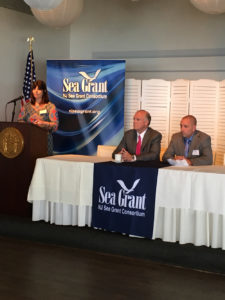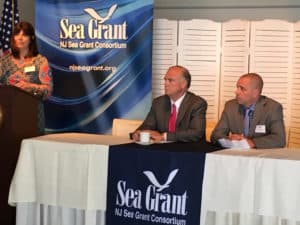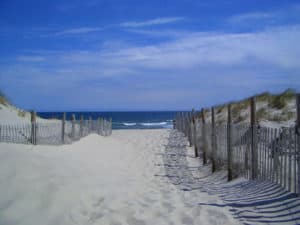
JERSEY SHORE – Tourism contributed some $44 billion to the New Jersey economy in 2016, and about half of that amount is generated at the Shore, said Department of Environmental Protection Commissioner Bob Martin at an annual media event, “New Jersey Sea Grant Consortium’s State of the Shore.”
It was the 15th annual event advertised as “an annual tradition, kicking off the Memorial Day weekend’s unofficial start to the summer beach season.”
Martin gave updates on New Jersey’s water quality and beach projects during a PowerPoint presentation held at Tim McLoone’s Pier House in Long Branch. He was followed by Professor Jon K. Miller, a coastal expert from the Stevens Institute of Technology, and then the men answered questions from members of the press.
“The beaches are going to be beautiful, they’re in great shape, the water quality is excellent, so we’re now in a great position as we move forward into the summer,” Martin said.

The DEP administers the Coastal Cooperative Monitoring Program along with the state Department of Health and local health agencies, utilizing two components: water quality monitoring and aerial surveillance.
Ocean water monitoring began on May 15, and would continue through Labor Day, he said.
Martin said that the DEP collects data on 216 ocean and bay beaches every Monday and the results are posted on their webpage by Tuesday.
Water samples are collected from primary stations located in Monmouth, Ocean, Atlantic, and Cape May Counties, he said.
The DEP conducts aerial surveillance to look for floatables, debris, algae blooms and anything else that might affect bathing water quality. Six weekly coastal surveillance flights that run up and down the coast would begin this week, Martin said, and run through the entire summer until mid-September.
In 2016, beaches were open 99.9 percent of the time, and bay beaches were open 99.6 percent of the time. Most closures were due to pollution caused by stormwater runoffs after rainfall, when fertilizer and animal waste gets into the sewers, he said.
Dr. Miller said that New Jersey beaches are in good shape since the shore had a relatively mild winter. “We got lucky, we only had two major storms,” he said.
The three contributors to beach erosion is the water level, the size of the waves, and the duration of the storm, Miller explained.
The nor’easter in late January resulted in moderate to severe ocean erosion, but it peaked and subsided quickly, he said.
He said the tropical storm forecast for the upcoming summer is higher than expected, with experts predicting 11 named storms, four hurricanes and two major hurricanes.
“We need to be prepared,” said Dr. Miller. “It only takes one storm, so we have to maintain vigilance,” he said.

After their presentations, Martin and Miller took questions from the press.
Several reporters asked about the proposed federal budget which would cut the EPA budget by about a third. The NJDEP relies on federal funds for many of its projects and programs.
“We have all the money we need this year – it’s too premature to talk about the Federal government,” Martin said. “We have to wait to see how it plays out. I’m confident that cooler heads will prevail. We have representatives who understand our problems.”
The Brick Times asked Martin how he would respond to the opinion of some coastal experts who say that with rising sea level some seaside communities might have to be vacated.
“We are not retreating from the shore, it’s a $20 billion industry in New Jersey,” Martin responded. “I want to be crystal clear about that.”
In response to a reporter’s question about the cost to NJ for post-Sandy coastal protection projects, Martin said that the vast majority were paid for with federal dollars because of Sandy legislation. He said the state portion, which was less than 10 percent, is being paid for with a long-term interest-free, federal loan.
Dr. Miller said that due to the sea level rise “nuisance flooding” has become more commonplace during high tides and full moons.
“There are studies underway. We’re doing work on back-bay areas and we might need to bolster some projects there,” he said.
Some of the engineering projects would include raising roads, creating berms, building bulkheads, pump stations, and more, he said.
“We have to think and plan long term to minimize impacts,” Miller said. “We can handle sea level rise for the moment. Although if there’s a catastrophe and the ice sheets melt, there would be a whole new scenario.”
Martin said that over the past several years the DEP has partnered with the Army Corps of Engineers on a number of post-Sandy coastal projects, including:
- $211 million for Union Beach. Phase 1 started in February, which created a new beach and dune system, including two groins. Phase 2 includes building flood walls with a completion date of November 2022.
- $105 million for Port Monmouth. New flood walls should be completed there by November 2020.
- $30 million for Sea Bright. A new sea wall is 90 percent completed as of May, and pre-Sandy gaps in the wall were removed.
- $140 million for ocean beaches in Monmouth County. The beach and dune replenishment project started three years ago, and should be completed by June 2017.
- $128 million for the ocean beaches in northern Ocean County. Martin said the project was supposed to start on Sunday May 28 with dredging starting in Ortley Beach. The multiple-phase project should be completed by June 2018, he said. The beach and dune replenishment project would provide 14 miles of coastal protection from Point Pleasant Beach to Island Beach State Park, and it would be the largest project ever done in New Jersey, Martin said.
- $151 million for Long Beach Island. The dune and beach replenishment project was completed in December 2016.
- $31 million in Atlantic City for a seawall, and $11 million for boardwalk construction. The completion date is set for March 2018.
- $64 million for Absecon Island, where a dune and beach replenishment program started two weeks ago.
- $97 million for multiple projects for Ocean City which would have “full coastal protection” by June 2016.
- $64 million for Stone Harbor, where rebuilt berms offering full coastal protection would be completed by November 2017.
- $14 million for Cape May City, where beach nourishment was completed last month.
Director of the New Jersey Sierra Club Jeff Tittel attended the media event and said New Jersey is not responding to the environmental needs of the shore in any real way. For example, they are not planning – mitigating or adapting to sea level rise.
“The sea walls are a false hope, and the dunes they are building are not real dunes. A berm is not a dune, and the next big nor’easter will wash them all away,” Tittel said after the presentation.
He said the planned dune and beach replenishment project would only make back bay flooding worse.
“They are taking away the sandbars in the ocean, which makes the waves get bigger and pushes more water into the bays,” Tittel said. “The New Jersey coast is facing some very serious problems,” he said.

In a press release, the Sierra Club said that the testing of beaches on a Monday leaves five days of untested water before the weekend, when most people swim. There is less money for testing, so the water is tested less and the beachgoers are ill-informed.
“Photo ops and press events do not make up for weakening environmental standards and the failure to protect our coasts,” Tittel said in the press release. “New Jersey’s way of dealing with the coast is just pumping more sand on the beach that will wash out in the next storm. They have no real plan to protect our coasts. We want people to go to the shore and not have to worry about the potential for illness. We want coastal communities to be able to be resilient against climate change. We want to have healthy ecosystems in our waterways. We want to make sure we have clean water for the people who use our beaches. We hope we have a very good summer season, but unless we start changing our policies and working to protect our shores, we’re putting New Jersey’s entire coastal environment and economy at risk.”






